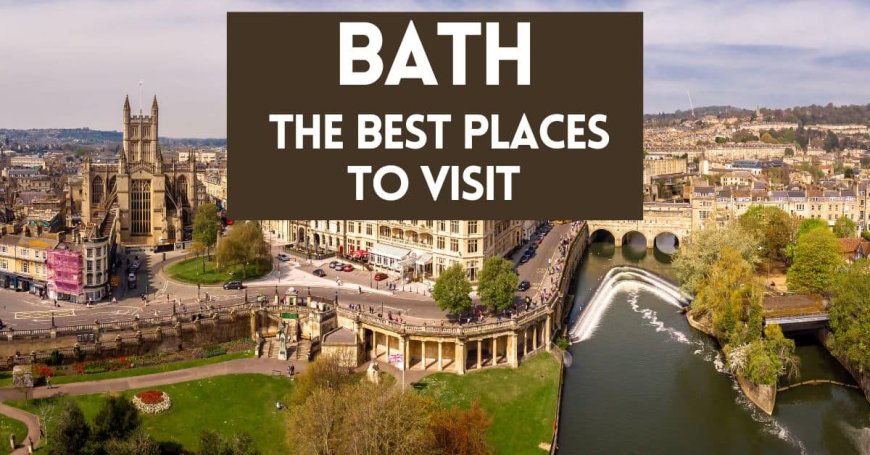Exploring Bath, England A Journey Through Time and Elegance
Exploring Bath, England A Journey Through Time and Elegance

Bath, England, is a city of timeless beauty, steeped in history and elegance. Nestled in the rolling countryside of Somerset, Bath has been a destination for relaxation and rejuvenation since Roman times. The city's stunning Georgian architecture, historic Roman baths, and vibrant cultural scene make it one of the most visited and cherished cities in the UK. Here’s an extensive guide to the best places to visit in Bath, England.
1. The Roman Baths
A Glimpse into Ancient Rome
The Roman Baths are among the finest historic sites in Northern Europe. These ancient baths were built by the Romans around 70 AD and have been meticulously preserved, offering visitors a unique glimpse into the past.
Key Attractions
The Great Bath: The centerpiece of the complex, the Great Bath, is a magnificent pool lined with 2,000-year-old paving stones. Visitors can see the steam rising from the hot spring that feeds the bath and imagine what it was like to bathe here in Roman times.
The Sacred Spring: The Sacred Spring is the heart of the Roman Baths. It was believed to be the home of the goddess Sulis Minerva, to whom the site was dedicated. The spring still flows with hot water, which bubbles up at a rate of 1.2 million liters per day.
The Pump Room: The elegant Pump Room, built in the 18th century, is now a restaurant where visitors can enjoy traditional afternoon tea while overlooking the Roman Baths. The Pump Room also houses a fountain where you can taste the mineral-rich spa water.
The Museum: The Roman Baths Museum houses a fascinating collection of artifacts discovered at the site, including coins, jewelry, and the famous Gorgon's head from the Temple of Sulis Minerva.
2. Bath Abbey
A Gothic Masterpiece
Bath Abbey, also known as the Abbey Church of Saint Peter and Saint Paul, is a stunning example of Gothic architecture. The Abbey has been a place of Christian worship for over 1,200 years and is one of Bath's most iconic landmarks.
Key Attractions
The Nave: The Abbey’s nave is a breathtaking space with a stunning fan-vaulted ceiling and beautiful stained glass windows. The intricate stonework and the sense of grandeur make it a must-see for visitors.
The Tower Tour: For a panoramic view of Bath, visitors can climb the 212 steps to the top of Bath Abbey's tower. The tour includes a visit to the ringing chamber and the bell chamber, as well as the chance to stand behind the clock face.
The West Front: The West Front of Bath Abbey is adorned with a series of stone carvings depicting angels ascending and descending ladders to heaven. This unique feature is a testament to the craftsmanship of the medieval builders.
The Abbey Vaults: The vaults beneath Bath Abbey house a fascinating exhibition about the history of the Abbey and the city of Bath. Visitors can learn about the lives of the people who have worshipped here over the centuries.
3. The Royal Crescent
Georgian Architecture at its Finest
The Royal Crescent is one of the most famous landmarks in Bath and a masterpiece of Georgian architecture. Designed by the architect John Wood the Younger and built between 1767 and 1775, the Royal Crescent consists of 30 terraced houses arranged in a sweeping crescent shape.
Key Attractions
No. 1 Royal Crescent: No. 1 Royal Crescent is a museum that offers visitors a glimpse into life in an 18th-century Georgian townhouse. The rooms are furnished with period furniture, paintings, and decorative arts, providing a fascinating insight into the lifestyle of Bath’s Georgian elite.
The Crescent Lawn: The lawn in front of the Royal Crescent offers a perfect spot for a leisurely stroll or a picnic. From here, you can enjoy the grandeur of the architecture and the stunning views over the city.
Royal Victoria Park: Located just behind the Royal Crescent, Royal Victoria Park is a beautiful public park that was opened by Queen Victoria in 1830. The park features beautifully landscaped gardens, a boating pond, and a children’s play area.
4. The Circus
A Harmonious Architectural Ensemble
The Circus, another of Bath’s iconic Georgian landmarks, was designed by John Wood the Elder and completed in 1768. The Circus consists of three curved segments of townhouses that form a perfect circle, creating a striking architectural ensemble.
Key Attractions
Architectural Details: The Circus is renowned for its intricate architectural details, including the classical columns that adorn the facades of the buildings. Each segment of the Circus features a different order of columns: Doric on the ground floor, Ionic on the first floor, and Corinthian on the second floor.
Historical Significance: The Circus has been home to many notable residents over the years, including the artist Thomas Gainsborough and the actor David Garrick. Walking around the Circus, visitors can appreciate the historical significance and the beauty of the architecture.
Connection to the Royal Crescent: The Circus is connected to the Royal Crescent by Brock Street, creating a continuous flow of elegant Georgian architecture. The alignment of the Circus and the Royal Crescent was designed to create a harmonious urban landscape.
5. Pulteney Bridge
A Unique and Picturesque Bridge
Pulteney Bridge is one of Bath’s most photographed landmarks. Completed in 1774 and designed by Robert Adam, the bridge is one of only four in the world to have shops built across its full span on both sides.
Key Attractions
The Architecture: Pulteney Bridge is an architectural gem, with its elegant arches and classical design. The bridge spans the River Avon and offers beautiful views of the river and the weir below.
The Shops: The bridge is lined with charming shops, cafes, and boutiques. Visitors can enjoy a leisurely stroll along the bridge, browsing for unique gifts and souvenirs.
The Weir: The crescent-shaped weir below Pulteney Bridge adds to the picturesque charm of the scene. The weir is a popular spot for photographers and provides a beautiful backdrop for a riverside walk.
6. The Jane Austen Centre
A Tribute to Bath’s Most Famous Resident
Jane Austen, one of England’s most beloved authors, lived in Bath from 1801 to 1806. The Jane Austen Centre is a museum dedicated to her life and work, offering visitors a chance to explore the city through her eyes.
Key Attractions
The Exhibition: The Jane Austen Centre features an exhibition that explores Jane Austen’s time in Bath and the impact the city had on her writing. The exhibition includes period costumes, personal letters, and a wealth of information about her life and works.
Costumed Guides: The museum’s guides, dressed in Regency-era costumes, bring Jane Austen’s world to life. They provide insightful commentary and answer questions about her life and the city of Bath.
The Regency Tea Room: The Regency Tea Room at the Jane Austen Centre offers a delightful experience for visitors. You can enjoy traditional afternoon tea, complete with scones, sandwiches, and pastries, while soaking in the Regency ambiance.
The Gift Shop: The gift shop at the Jane Austen Centre offers a wide range of Austen-related merchandise, including books, jewelry, and period costumes. It’s the perfect place to find a souvenir of your visit.
7. The Thermae Bath Spa
Modern Relaxation in Historic Waters
The Thermae Bath Spa is a modern spa complex that allows visitors to experience the thermal waters that have made Bath famous for millennia. The spa combines contemporary design with historic features, offering a unique and luxurious experience.
Key Attractions
The Rooftop Pool: The rooftop pool at Thermae Bath Spa offers stunning views over the city of Bath. The pool is filled with the naturally warm, mineral-rich waters that have been used for therapeutic purposes since Roman times.
The Minerva Bath: The Minerva Bath is the largest of the spa’s pools and features a lazy river, massage jets, and a whirlpool. The pool is named after the Roman goddess of health and wisdom.
The Wellness Suite: The Wellness Suite at Thermae Bath Spa offers a range of steam rooms, saunas, and relaxation areas. The suite is designed to enhance the therapeutic benefits of the thermal waters.
Spa Treatments: The spa offers a variety of treatments, including massages, facials, and body wraps. Visitors can indulge in luxurious treatments that use natural and locally-sourced products.
8. The Holburne Museum
Art and Culture in a Historic Setting
The Holburne Museum is one of Bath’s premier cultural attractions, housing an impressive collection of fine and decorative arts. The museum is located in the former Sydney Hotel, a beautiful Georgian building at the end of Great Pulteney Street.
Key Attractions
The Collection: The Holburne Museum’s collection includes paintings, sculptures, ceramics, and decorative arts from the Renaissance to the 18th century. Highlights include works by Gainsborough, Stubbs, and Turner.
The Gardens: The museum is set in the beautiful Sydney Gardens, which are the only remaining pleasure gardens in the country. Visitors can enjoy a leisurely stroll through the gardens, which feature historic pathways, a replica Roman temple, and a canal.
Special Exhibitions: The Holburne Museum hosts a range of special exhibitions throughout the year, showcasing works from major international collections as well as contemporary art.
The Café: The museum’s café offers a delightful spot for a meal or a snack, with indoor seating and a terrace that overlooks the gardens. The café serves a range of freshly-prepared dishes and traditional afternoon tea.
9. Prior Park Landscape Garden
A Picturesque 18th-Century Garden
Prior Park Landscape Garden, designed by the famous landscape architect Capability Brown, is a stunning example of an 18th-century English garden. The garden is located on the southern edge of Bath and offers breathtaking views over the city.
Key Attractions
The Palladian Bridge: One of only four Palladian bridges in the world, the bridge at Prior Park is a highlight of the garden. The elegant structure spans a small lake and provides a picturesque focal point.
The Grotto: The garden features a charming grotto, a popular feature in 18th-century landscape gardens. The grotto offers a cool and peaceful retreat, with views of the surrounding landscape.
The Serpentine Lake: The serpentine lake winds its way through the garden, reflecting the beauty of the trees and plants that line its banks. The lake is home to a variety of wildlife, including swans and ducks.
The Views: Prior Park Landscape Garden offers some of the best views of Bath. From the garden’s higher points, visitors can enjoy panoramic vistas of the city’s skyline and the surrounding countryside.
10. The Fashion Museum
A Journey Through Fashion History
The Fashion Museum in Bath houses one of the finest collections of historical and contemporary dress in the world. Located in the Assembly Rooms, the museum offers a fascinating insight into the history of fashion.
Key Attractions
The Collection: The museum’s collection includes over 100,000 objects, ranging from Georgian gowns to contemporary designer dresses. The displays are regularly updated to reflect new acquisitions and changing fashion trends.
The Assembly Rooms: The Fashion Museum is housed in the historic Assembly Rooms, a beautiful Georgian building that once hosted Bath’s high society. Visitors can explore the elegant Ball Room, Tea Room, and Octagon Room.
Dressing Up: The museum offers visitors the chance to try on replica historic costumes. This interactive experience is popular with visitors of all ages and provides a fun way to engage with fashion history.
Special Exhibitions: The Fashion Museum hosts a range of special exhibitions, showcasing iconic garments and exploring themes such as royal fashion, film costumes, and fashion photography.
What's Your Reaction?
 Like
0
Like
0
 Dislike
0
Dislike
0
 Love
0
Love
0
 Funny
0
Funny
0
 Angry
0
Angry
0
 Sad
0
Sad
0
 Wow
0
Wow
0








































































































